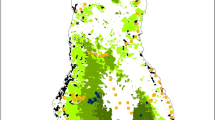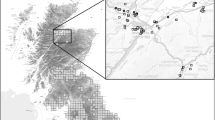Abstract
The Caucasian black grouse (CBG) is classified as “data deficient” by the IUCN. Lack of information to guide conservation measures is mainly due to the bird’s elusive behaviour for much of the year and to its remote distribution at higher altitudes of the Caucasus Mountains. In order to fill some of the knowledge gaps, we mapped potential suitable habitat across the Turkish part of the Lesser Caucasus using a spatial regression model, and estimated the total CBG population from alternative assumptions on population density and habitat separation. The CBG model was derived from 167 CBG records obtained during a survey in representative areas of the Turkish Caucasus, in conjunction with a supervised habitat classification of satellite images and with topographic parameters calculated from a digital elevation model. In total, approx. 5,000 km2 of suitable habitat were predicted to exist within the borders of Turkey, including areas where the CBG has not previously been searched for. Under conservative assumptions, this area can carry more than 4,800 individuals, which is higher than previously estimated. The predicted distribution map can be used to select priority areas for conservation and to specify additional survey locations of the species in areas, which so far have been less well sampled.

Similar content being viewed by others
References
Akaike H (1973) Information theory as an extension of the maximum likelihood principle. In: Petrov BN, Csaki F (eds) Second international symposium on information theory, Akademiai Kiado, Budapest, pp 267–281
Akman Y (1995) Türkiye Orman Vejetasyonu—forest vegetation of Turkey, Ankara (in Turkish)
Atalay İ (1994) Türkiye Vejetasyon Cografyasi—vegetation geography of Turkey, Izmir (in Turkish with English summary)
Atalay İ (2002) Türkiye’nin ekolojik bölgeleri—Ecoregions of Turkey, Izmir (in Turkish with English summary)
Atkinson PW, Humpage EA, Jowitt AJD, Ogurlu I, Rowcliffe JM (1995) The distribution and status of Caucasian Black Grouse in north-eastern Turkey. In: Jenkins D (ed) Proceedings of the 6th international symposium on grouse. World Pheasant Association, Udine, pp 131–133
Baskaya S (1997) Dag horozu (Caucasian black grouse)—Dostlar Rasgele Av-Doğa Kültürel Dergisi (in Turkish) 4:22–23
Baskaya S (2003) Distribution and principal threats to Caucasian black grouse Tetrao mlokosiewiczi in the Eastern Karadeniz Mountains in Turkey. Wildl Biol 9:377–383
Betts MG, Diamond AW, Forbes GJ, Villard M-A, Gunn JS (2006) The importance of spatial autocorrelation, extent and resolution in predicting forest bird occurrence. Ecol Model 191:197–224
Beven KJ, Kirkby MJ (1979) A physically based, variable contributing area model of basin hydrology. Hydrol Sci Bull 24:43–69
BirdLife International (2006) Caucasian Black Grouse—‘Birds in Europe’ factsheet. url: http://www.birdlife.org/datazone/species/BirdsInEuropeII/BiE2004Sp294.pdf
Boyce MS, Vernier PR, Nielsen SE, Schmiegelow FKA (2002) Evaluating resource selection functions. Ecol Model 157:281–300
Burnham KP, Anderson DR (2002) Model selection and multimodel inference: a practical information-theoretic approach, 2nd edn. Springer, Berlin Heidelberg New York
Campbell JB (2002) Introduction to remote sensing. Guildford Press, New York
Drovetski SV, Rohwer S (2000) Habitat use, chick survival and density of Caucasian black grouse Tetrao mlokosiewiczi. Wildl Biol 6:233–240
Engler R, Guisan A, Rechsteiner L (2004) An improved approach for predicting the distribution of rare and endangered species from occurrence and pseudo-absence data. J Appl Ecol 41:263–274
Etzold J (2003) Kennzeichnung des Lebensraumes des Kaukasus-birkhuhuns Tetrao mlokosiewiczi im Ostkaukasus. Thesis, University Greifswald
Fielding AH, Bell JF (1997) A review of methods for the assessment of prediction errors in conservation presence/absence models. Environ Conserv 24:38–49
GCCW (2005) A model to predict the occurrence of Caucasian grouse in Georgia. Georgian Center for the Conservation of Wildlife (GCCW), Tbilisi. Unpublished report
Gokhelashvili R, Reese KP, Gavashelishvili L (2003) How much do we know about the Caucasian Black Grouse Tetrao mlokosiewiczi? Sandgrouse 25:32–40
Gottschalk TK, Ekschmitt K, Wolters V, Misok A, Weiste M (2006) GEPARD Version 1.1. Department of Animal Ecology, Justus-Liebig-University Giessen. url: http://www.sfb299.de/GEPARD
IUCN (2004) Tetrao mlokosiewiczi. In: IUCN 2006. 2006 IUCN Red List of Threatened Species. url: http://www.iucnredlist.org. Downloaded on 14 May 2007
Klaus S, Storch I (2003) Autumn display of the Caucasian black grouse Tetrao mlokosiewiczi—observations in the Kazbegi reserve/Georgia. Grouse News 26:11–12
Klaus S, Bergmann H-H, Marti C, Müller F, Vitovich OA, Wisner J (1990) Die Birkhühner Tetrao tetrix und T. mlokosiewiczi. Ziemsen, Wittenberg Lutherstadt
Klaus S, Bergmann H-H, Wiesner J, Vitovich OA, Etzold J, Sultanov E (2003) Behaviour and ecology of the Caucasian Grouse Tetrao mlokosiewiczi—silent courtship on steep slopes. Limicola 17:255–268 (in German with English summary)
Legendre P (1993) Spatial autocorrelation: trouble or new paradigm? Ecology 74:1659–1673
Liu C, Berry PM, Dawson TP, Pearson RG (2005) Selecting thresholds of occurrence in the prediction of species distributions. Ecography 28:385–393
McCune B, Keon D (2002) Equations for potential annual direct incident radiation and heat load index. J Veg Sci 13:603–606
Manly BFJ, McDonald LL, Thomas DL, McDonald TL, Erickson WP (2002) Resource selection by animals: statistical design and analysis for field studies. Kluwer, Dordrecht
Mayer H, Aksoy H (1986) Wälder der Türkei. Gustav Fischer, Stuttgart
Osborne PE, Alonso JC, Bryant RG (2001) Modelling landscape-scale habitat use using GIS and remote sensing: a case study with great bustards. J Appl Ecol 38:458–471
Pearce J, Ferrier S (2000) Evaluating the predictive performance of habitat models developed using logistic regression. Ecol Model 133:225–245
Pirselimoglu H (1990) 40 years in hunting (Avcılıkta 40 yıl). Hilal Matb. Koll. Şti., İstanbul
Poirazidis K, Goutner V, Skartsi T, Stamou G (2004) Modelling nesting habitat as a conservation tool for the Eurasian black vulture (Aegypius monachus) in Dadia Nature Reserve, northeastern Greece. Biol Conserv 118:235–248
Potapov RL (1985) Order Galliformes. Part 2. Family Tetraonidae. Fauna of the USSR, new series 133. Birds, vol. 3, issue 1. Leningrad (In Russian)
R Development Core Team (2006) R: A language and environment for statistical computing. R Foundation for Statistical Computing. url: http://www.R-project.org
Rice WR (1989) Analyzing tables of statistical tests. Evolution 43:223–225
Storch I (2000) Grouse Status Survey and Conservation Action Plan 2000–2004—WPA/BirdLife/SSC Grouse Specialist Group/IUCN. Gland, Cambridge
Sultanov E (2006) Surveys in Caucasian black grouse habitats in Azerbaijan. Newsletter of the WPA/BirdLife/IUCN/SSC Grouse Specialist Group 31:25–28
Turkish Ministry of Environment and Forestry (2005) Digital elevation model of Turkey. Directorate of Mapping & Photogrammetry in the General Directorate of Forestry of the Ministry of Environment and Forestry. Ankara, Turkey
Verbyla DL, Litvaitis JA (1989) Resampling methods for evaluating classification accuracy of wildlife habitat models. Environ Manage 13:783–787
Vitovich OA (1986) Ecologia kavkaskovo tetereva (Ecology of the Caucasian black grouse) (in Russian). Tr Teberdinsk Zapov 10:165–309
Zweig MH, Campbell G (1993) Receiver-operating characteristic (ROC) plots: a fundamental evaluation tool in clinical medicine. Clin Chem 39:561–577
Acknowledgments
We wish to thank Onder Cirik, and Luke Smith for conducting some of the Caucasian black grouse surveys, and Cenk Türkman, Nilüfer Arac, Ayse Könte, Murat Bozdogan for assistance in the field. We thank the Directorate of Mapping and Photogrammetry in the General Directorate of Forestry within the Ministry of Environment and Forestry of the Republic of Turkey, for providing satellite images, digital elevation data and topographic maps. This research was funded by the Baku Tbilisi Ceyhan Crude Oil Pipeline Project Environmental Investment Program and complies with the current laws of Germany and Turkey. We thank one anonymous reviewer and Siegfried Klaus for constructive comments on early drafts of this manuscript.
Author information
Authors and Affiliations
Corresponding author
Additional information
Communicated by F. Bairlein.
Rights and permissions
About this article
Cite this article
Gottschalk, T.K., Ekschmitt, K., İsfendiyaroglu, S. et al. Assessing the potential distribution of the Caucasian black grouse Tetrao mlokosiewiczi in Turkey through spatial modelling. J Ornithol 148, 427–434 (2007). https://doi.org/10.1007/s10336-007-0155-z
Received:
Revised:
Accepted:
Published:
Issue Date:
DOI: https://doi.org/10.1007/s10336-007-0155-z




